Abstract
The effectiveness of genetic engineering with lentivectors to protect transplanted cells from allogeneic rejection was examined using, as a model, type 1 diabetes treatment with β-cell transplantation, whose widespread use has been limited by the requirement for sustained immunosuppressive treatment to prevent graft rejection. We examined whether lentivectors expressing select immunosuppressive proteins encoded by the adenoviral genome early region 3 (AdE3) would protect transplanted β-cells from an alloimmune attack. The insulin-producing β-cell line βTC-tet (C3HeB/FeJ-derived) was transduced with lentiviruses encoding the AdE3 proteins gp19K and RIDα/β. The efficiency of lentiviral transduction of βTC-tet cells exceeded 85%. Lentivector expression of gp19K decreased surface class I major histocompatibility complex expression by over 90%, whereas RIDα/β expression inhibited cytokine-induced Fas upregulation by over 75%. βTC-tet cells transduced with gp19K and RIDα/β lentivectors, but not with a control lentivector, provided prolonged correction of hyperglycemia after transplantation into diabetic BALB/c severe combined immunodeficient mice reconstituted with allogeneic immune effector cells or into diabetic allogeneic BALB/c mice. Thus, genetic engineering of β-cells using gp19K- and RIDα/β-expressing lentiviral vectors may provide an alternative that has the potential to eliminate or reduce treatment with the potent immunosuppressive agents necessary at present for prolonged engraftment with transplanted islets.
This is a preview of subscription content, access via your institution
Access options
Subscribe to this journal
Receive 12 print issues and online access
$259.00 per year
only $21.58 per issue
Buy this article
- Purchase on Springer Link
- Instant access to full article PDF
Prices may be subject to local taxes which are calculated during checkout






Similar content being viewed by others
References
Edge AS . Current applications of cellular xenografts. Transplant Proc 2000; 32: 1169–1171.
Ryan EA, Paty BW, Senior PA, Bigam D, Alfadhli E, Kneteman NM et al. Five-year follow-up after clinical islet transplantation. Diabetes 2005; 54: 2060–2069.
Balamurugan AN, Bottino R, Giannoukakis N, Smetanka C . Prospective and challenges of islet transplantation for the therapy of autoimmune diabetes. Pancreas 2006; 32: 231–243.
Nir T, Melton DA, Dor Y . Recovery from diabetes in mice by β cell regeneration. J Clin Invest 2007; 117: 2553–2561.
Shapiro AM, Ricordi C, Hering BJ, Auchincloss H, Lindblad R, Robertson RP et al. International trial of the Edmonton protocol for islet transplantation. N Engl J Med 2006; 355: 1318–1330.
Horwitz MS . Function of adenovirus E3 proteins and their interactions with immunoregulatory cell proteins. J Gene Med 2004; 6 (Suppl 1): S172–S183.
Benedict CA, Norris PS, Prigozy TI, Bodmer JL, Mahr JA, Garnett CT et al. Three adenovirus E3 proteins cooperate to evade apoptosis by tumor necrosis factor-related apoptosis-inducing ligand receptor-1 and -2. J Biol Chem 2001; 276: 3270–3278.
Gooding LR, Ranheim TS, Tollefson AE, Aquino L, Duerksen-Hughes P, Horton TM et al. The 10,400- and 14,500-dalton proteins encoded by region E3 of adenovirus function together to protect many but not all mouse cell lines against lysis by tumor necrosis factor. J Virol 1991; 65: 4114–4123.
Shisler J, Yang C, Walter B, Ware CF, Gooding LR . The adenovirus E3-10.4K/14.5K complex mediates loss of cell surface Fas (CD95) and resistance to Fas-induced apoptosis. J Virol 1997; 71: 8299–8306.
Friedman JM, Horwitz MS . Inhibition of tumor necrosis factor alpha-induced NF-κB activation by the adenovirus E3-10.4/14.5K complex. J Virol 2002; 76: 5515–5521.
Delgado-Lopez F, Horwitz MS . Adenovirus RIDαβ complex inhibits lipopolysaccharide signaling without altering TLR4 cell surface expression. J Virol 2006; 80: 6378–6386.
Burgert HG, Maryanski JL, Kvist S . ‘E3/19K’ protein of adenovirus type 2 inhibits lysis of cytolytic T lymphocytes by blocking cell-surface expression of histocompatibility class I antigens. Proc Natl Acad Sci USA 1987; 84: 1356–1360.
Beilke J, Johnson Z, Kuhl N, Gill RG . A major role for host MHC class I antigen presentation for promoting islet allograft survival. Transplant Proc 2004; 36: 1173–1174.
Sigrist S, Ebel N, Langlois A, Bosco D, Toso C, Kleiss C et al. Role of chemokine signaling pathways in pancreatic islet rejection during allo- and xenotransplantation. Transplant Proc 2005; 37: 3516–3518.
Eizirik DL, Mandrup-Poulsen T . A choice of death—the signal-transduction of immune-mediated beta-cell apoptosis. Diabetologia 2001; 44: 2115–2133.
Yang Y, Santamaria P . Dissecting autoimmune diabetes through genetic manipulation of non-obese diabetic mice. Diabetologia 2003; 46: 1447–1464.
Efrat S, Fejer G, Brownlee M, Horwitz MS . Prolonged survival of pancreatic islet allografts mediated by adenovirus immunoregulatory transgenes. Proc Natl Acad Sci USA 1995; 92: 6947–6951.
Efrat S, Serreze D, Svetlanov A, Post CM, Johnson EA, Herold K et al. Adenovirus early region 3 (E3) immunomodulatory genes decrease the incidence of autoimmune diabetes in NOD mice. Diabetes 2001; 50: 980–984.
Pierce MA, Chapman HD, Post CM, Svetlanov A, Efrat S, Horwitz M et al. Adenovirus early region 3 antiapoptotic 10.4K, 14.5K, and 14.7K genes decrease the incidence of autoimmune diabetes in NOD mice. Diabetes 2003; 52: 1119–1127.
von Herrath MG, Efrat S, Oldstone MB, Horwitz MS . Expression of adenoviral E3 transgenes in β cells prevents autoimmune diabetes. Proc Natl Acad Sci USA 1997; 94: 9808–9813.
Levine BL, Humeau LM, Boyer J, MacGregor RR, Rebello T, Lu X et al. Gene transfer in humans using a conditionally replicating lentiviral vector. Proc Natl Acad Sci USA 2006; 103: 17372–17377.
Efrat S, Fusco-DeMane D, Lemberg H, al Emran O, Wang X . Conditional transformation of a pancreatic β-cell line derived from transgenic mice expressing a tetracycline-regulated oncogene. Proc Natl Acad Sci USA 1995; 92: 3576–3580.
Fleischer N, Chen C, Surana M, Leiser M, Rossetti L, Pralong W et al. Functional analysis of a conditionally transformed pancreatic β-cell line. Diabetes 1998; 47: 1419–1425.
Szymczak AL, Workman CJ, Wang Y, Vignali KM, Dilioglou S, Vanin EF et al. Correction of multi-gene deficiency in vivo using a single ‘self-cleaving’ 2A peptide-based retroviral vector. Nat Biotechnol 2004; 22: 589–594.
Follenzi A, Naldini L . Generation of HIV-1 derived lentiviral vectors. Methods Enzymol 2002; 346: 454–465.
Petrovsky N, Silva D, Socha L, Slattery R, Charlton B . The role of Fas ligand in beta cell destruction in autoimmune diabetes of NOD mice. Ann N Y Acad Sci 2002; 958: 204–208.
Dupraz P, Rinsch C, Pralong WF, Rolland E, Zufferey R, Trono D et al. Lentivirus-mediated Bcl-2 expression in βTC-tet cells improves resistance to hypoxia and cytokine-induced apoptosis while preserving in vitro and in vivo control of insulin secretion. Gene Therapy 1999; 6: 1160–1169.
Gallichan WS, Kafri T, Krahl T, Verma IM, Sarvetnick N . Lentivirus-mediated transduction of islet grafts with interleukin 4 results in sustained gene expression and protection from insulitis. Hum Gene Ther 1998; 9: 2717–2726.
Grey ST, Arvelo MB, Hasenkamp W, Bach FH, Ferran C . A20 inhibits cytokine-induced apoptosis and nuclear factor κB-dependent gene activation in islets. J Exp Med 1999; 190: 1135–1146.
Machen J, Bertera S, Chang Y, Bottino R, Balamurugan AN, Robbins PD et al. Prolongation of islet allograft survival following ex vivo transduction with adenovirus encoding a soluble type 1 TNF receptor-Ig fusion decoy. Gene Therapy 2004; 11: 1506–1514.
Papeta N, Chen T, Vianello F, Gererty L, Malik A, Mok YT et al. Long-term survival of transplanted allogeneic cells engineered to express a T cell chemorepellent. Transplantation 2007; 83: 174–183.
Rabinovitch A, Suarez-Pinzon W, Strynadka K, Ju Q, Edelstein D, Brownlee M et al. Transfection of human pancreatic islets with an anti-apoptotic gene (bcl-2) protects β-cells from cytokine-induced destruction. Diabetes 1999; 48: 1223–1229.
Lunsford KE, Gao D, Eiring AM, Wang Y, Frankel WL, Bumgardner GL . Evidence for tissue-directed immune responses: analysis of CD4- and CD8-dependent alloimmunity. Transplantation 2004; 78: 1125–1133.
Elsing A, Burgert HG . The adenovirus E3/10.4K-14.5K proteins down-modulate the apoptosis receptor Fas/Apo-1 by inducing its internalization. Proc Natl Acad Sci USA 1998; 95: 10072–10077.
Kobinger GP, Deng S, Louboutin JP, Vatamaniuk M, Matschinsky F, Markmann JF et al. Transduction of human islets with pseudotyped lentiviral vectors. Hum Gene Ther 2004; 15: 211–219.
Keir ME, Francisco LM, Sharpe AH . PD-1 and its ligands in T-cell immunity. Curr Opin Immunol 2007; 19: 309–314.
Ilan Y, Droguett G, Chowdhury NR, Li Y, Sengupta K, Thummala NR et al. Insertion of the adenoviral E3 region into a recombinant viral vector prevents antiviral humoral and cellular immune responses and permits long-term gene expression. Proc Natl Acad Sci USA 1997; 94: 2587–2592.
Ravelingien A . Xenotransplantation: the ethical and legal concerns. Xenotransplantation 2007; 14: 653–654.
Efrat S . Beta-cell replacement for insulin-dependent diabetes mellitus. Adv Drug Deliv Rev 2008; 60: 114–123.
Sapir T, Shternhall K, Meivar-Levy I, Blumenfeld T, Cohen H, Skutelsky E et al. Cell-replacement therapy for diabetes: generating functional insulin-producing tissue from adult human liver cells. Proc Natl Acad Sci USA 2005; 102: 7964–7969.
Zalzman M, Gupta S, Giri RK, Berkovich I, Sappal BS, Karnieli O et al. Reversal of hyperglycemia in mice by using human expandable insulin-producing cells differentiated from fetal liver progenitor cells. Proc Natl Acad Sci USA 2003; 100: 7253–7258.
Joseph A, Zheng JH, Follenzi A, Dilorenzo T, Sango K, Hyman J et al. Lentiviral vectors encoding human immunodeficiency virus type 1 (HIV-1)-specific T-cell receptor genes efficiently convert peripheral blood CD8 T lymphocytes into cytotoxic T lymphocytes with potent in vitro and in vivo HIV-1-specific inhibitory activity. J Virol 2008; 82: 3078–3089.
D’Ambra R, Surana M, Efrat S, Starr RG, Fleischer N . Regulation of insulin secretion from β-cell lines derived from transgenic mice insulinomas resembles that of normal β cells. Endocrinology 1990; 126: 2815–2822.
Acknowledgements
This work was supported by the National Institutes of Health (National Institute of Diabetes and Digestive and Kidney Diseases P01DK52956 and P60DK20541 and National Institute of Allergy and Infectious Diseases AI67136 and the Einstein/MMC Center for AIDS Research AI51519).
Author information
Authors and Affiliations
Corresponding author
Additional information
Conflict of interest
The authors declare no conflict of interest.
Rights and permissions
About this article
Cite this article
Kojaoghlanian, T., Joseph, A., Follenzi, A. et al. Lentivectors encoding immunosuppressive proteins genetically engineer pancreatic β-cells to correct diabetes in allogeneic mice. Gene Ther 16, 340–348 (2009). https://doi.org/10.1038/gt.2008.172
Received:
Revised:
Accepted:
Published:
Issue Date:
DOI: https://doi.org/10.1038/gt.2008.172
Keywords
This article is cited by
-
Genetically Engineered Human Islets Protected From CD8-mediated Autoimmune Destruction In Vivo
Molecular Therapy (2013)
-
Exploiting human herpesvirus immune evasion for therapeutic gain: potential and pitfalls
Immunology & Cell Biology (2011)



